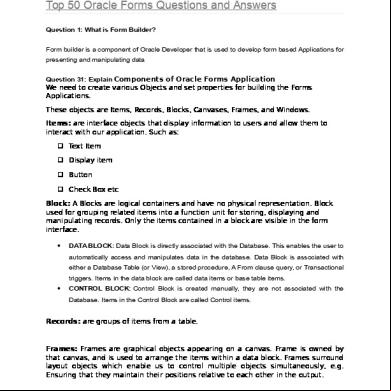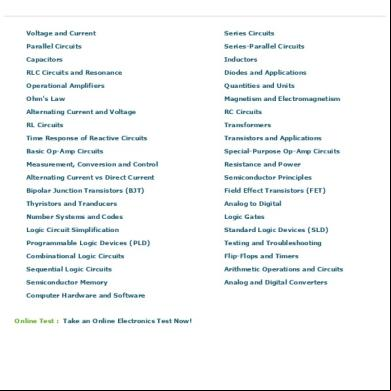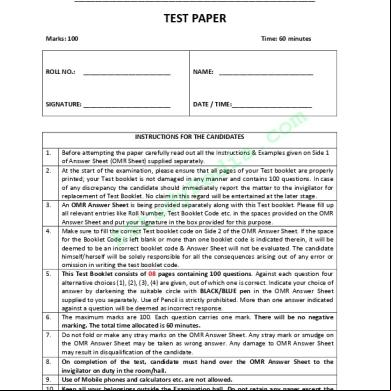50 Top Power Electronics Questions And Answers Pdf.pdf 29331n
This document was ed by and they confirmed that they have the permission to share it. If you are author or own the copyright of this book, please report to us by using this report form. Report 2z6p3t
Overview 5o1f4z
& View 50 Top Power Electronics Questions And Answers Pdf.pdf as PDF for free.
More details 6z3438
- Words: 842
- Pages: 5
SSC JE, UPSC ESE, IES, GATE 2018, IIT-JAM 2017, RAJASTHAN JEN, DMRC, DRDO, RAILWAY JE, METRO And All Engineering Study Material, Books And Guidance our android app
ER-Exams App :- click here
50 TOP POWER ELECTRONICS Questions and Answers pdf | MCQs
POWER ELECTRONICS Questions and Answers pdf :1. A Triac has three terminals viz ……………… 1. Drain, source, gate 2. Two main terminal and a gate terminal
3. 4.
Cathode, anode, gate None of the above
Ans : 2
2. A triac is equivalent to two SCRs ………….. 1. In parallel 2. In series 3. In inverse-parallel 4. None of the above Ans : 3
3. A triac is a …………. switch 1. Bidirectional 2. Unidirectional 3. Mechanical 4. None of the above Ans : 1
POWER ELECTRONICS Questions and Answers pdf
4. The V-I characteristics for a triac in the first and third quadrants are essentially identical to those of ………………. in its first quadrant 1. Transistor 2. SCR 3. UJT 4. none of the above Ans : 2
5. A triac can a portion of …………… half-cycle through the load 1. Only positive 2. Only negative 3. Both positive and negative 4. None of the above Ans : 3
6. A diac has ………….. terminals 1. Two 2. Three 3. Four 4. None of the above Ans : 1
7. A triac has …………….. semiconductor layers 1. Two 2. Three 3. Four 4. Five Ans : 3
8. A diac has …………… pn junctions 1. Four 2. Two 3. Three 4. None of the above Ans : 2
9. The device that does not have the gate terminal is ………………. 1. Triac 2. FET 3. SCR 4. Diac Ans : 4
10. A diac has ……………… semiconductor layers 1. Three 2. Two 3. Four 4. None of the above Ans : 1
11. A UJT has ………………. 1. Two pn junctions 2. One pn junction 3. Three pn junctions 4. None of the above Ans : 2
12. The normal way to turn on a diac is by ……………….. 1. Gate current 2. Gate voltage 3. Breakover voltage 4. None of the above Ans : 3
13. A diac is …………………. switch 1. An c. 2. A d.c. 3. A mechanical 4. None of the above Ans : 1
14. In a UJT, the p-type emitter is ……………. doped 1. Lightly 2. Heavily 3. Moderately 4. None of the above Ans : 2
15. Power electronics essentially deals with control of a.c. power at ………… 1. Frequencies above 20 kHz 2. Frequencies above 1000 kHz 3. Frequencies less than 10 Hz 4. 50 Hz frequency Ans : 4
16. When the emitter terminal of a UJT is open, the resistance between the base terminal is generally ……………….. 1. High 2. Low 3. Extremely low 4. None of the above Ans : 1
17. When a UJT is turned ON, the resistance between emitter terminal and lower base terminal ……………. 1. Remains the same 2. Is decreased 3. Is increased 4. None of the above Ans : 2
18. To turn on UJT, the forward bias on the emitter diode should be …………… the peak point voltage 1. Less than 2. Equal to 3. More than 4. None of the above Ans : 3
19. A UJT is sometimes called …………. diode 1. Low resistance 2. High resistance 3. Single-base 4. Double-base Ans : 4
20. When the temperature increases, the inter-base resistance (RBB) of a UJT …………. 1. Increases 2. Decreases 3. Remains the same 4. None of the above Ans : 1
21. When the temperature increases, the intrinsic stand off ratio ………. 1. Increases 2. Decreases 3. Essentially remains the same 4. None of the above Ans : 3
22. Between the peak point and the valley point of UJT emitter characteristics we have ………….. region 1. Saturation 2. Negative resistance 3. Cut-off 4. None of the above Ans : 2
24. A diac is turned on by ………………… 1. A breakover voltage
2. 3. 4.
Gate voltage Gate current None of the above
Ans : 1
25. The device that exhibits negative resistance region is ……………….. 1. Diac 2. Triac 3. Transistor 4. UJT Ans : 4
26. The UJT may be used as ………………. 1. Am amplifier 2. A sawtooth generator 3. A rectifier 4. None of the above Ans : 2
27. A diac is simply ……………… 1. A single junction device 2. A three junction device 3. A triac without gate terminal 4. None of the above Ans : 3
28. After peak point, the UJT operates in the ……………. region 1. Cut-off 2. Saturation 3. Negative resistance 4. None of the above Ans : 3
29. Which of the following is not a characteristic of UJT? 1. Intrinsic stand off ratio 2. Negative resistance 3. Peak-point voltage 4. Bilateral conduction Ans : 4
30. The triac is ……………. 1. Like a bidirectional SCR 2. A four-terminal device 3. Not a thyristor 4. Answers (1) and (2) Ans : 1
ER-Exams App :- click here
50 TOP POWER ELECTRONICS Questions and Answers pdf | MCQs
POWER ELECTRONICS Questions and Answers pdf :1. A Triac has three terminals viz ……………… 1. Drain, source, gate 2. Two main terminal and a gate terminal
3. 4.
Cathode, anode, gate None of the above
Ans : 2
2. A triac is equivalent to two SCRs ………….. 1. In parallel 2. In series 3. In inverse-parallel 4. None of the above Ans : 3
3. A triac is a …………. switch 1. Bidirectional 2. Unidirectional 3. Mechanical 4. None of the above Ans : 1
POWER ELECTRONICS Questions and Answers pdf
4. The V-I characteristics for a triac in the first and third quadrants are essentially identical to those of ………………. in its first quadrant 1. Transistor 2. SCR 3. UJT 4. none of the above Ans : 2
5. A triac can a portion of …………… half-cycle through the load 1. Only positive 2. Only negative 3. Both positive and negative 4. None of the above Ans : 3
6. A diac has ………….. terminals 1. Two 2. Three 3. Four 4. None of the above Ans : 1
7. A triac has …………….. semiconductor layers 1. Two 2. Three 3. Four 4. Five Ans : 3
8. A diac has …………… pn junctions 1. Four 2. Two 3. Three 4. None of the above Ans : 2
9. The device that does not have the gate terminal is ………………. 1. Triac 2. FET 3. SCR 4. Diac Ans : 4
10. A diac has ……………… semiconductor layers 1. Three 2. Two 3. Four 4. None of the above Ans : 1
11. A UJT has ………………. 1. Two pn junctions 2. One pn junction 3. Three pn junctions 4. None of the above Ans : 2
12. The normal way to turn on a diac is by ……………….. 1. Gate current 2. Gate voltage 3. Breakover voltage 4. None of the above Ans : 3
13. A diac is …………………. switch 1. An c. 2. A d.c. 3. A mechanical 4. None of the above Ans : 1
14. In a UJT, the p-type emitter is ……………. doped 1. Lightly 2. Heavily 3. Moderately 4. None of the above Ans : 2
15. Power electronics essentially deals with control of a.c. power at ………… 1. Frequencies above 20 kHz 2. Frequencies above 1000 kHz 3. Frequencies less than 10 Hz 4. 50 Hz frequency Ans : 4
16. When the emitter terminal of a UJT is open, the resistance between the base terminal is generally ……………….. 1. High 2. Low 3. Extremely low 4. None of the above Ans : 1
17. When a UJT is turned ON, the resistance between emitter terminal and lower base terminal ……………. 1. Remains the same 2. Is decreased 3. Is increased 4. None of the above Ans : 2
18. To turn on UJT, the forward bias on the emitter diode should be …………… the peak point voltage 1. Less than 2. Equal to 3. More than 4. None of the above Ans : 3
19. A UJT is sometimes called …………. diode 1. Low resistance 2. High resistance 3. Single-base 4. Double-base Ans : 4
20. When the temperature increases, the inter-base resistance (RBB) of a UJT …………. 1. Increases 2. Decreases 3. Remains the same 4. None of the above Ans : 1
21. When the temperature increases, the intrinsic stand off ratio ………. 1. Increases 2. Decreases 3. Essentially remains the same 4. None of the above Ans : 3
22. Between the peak point and the valley point of UJT emitter characteristics we have ………….. region 1. Saturation 2. Negative resistance 3. Cut-off 4. None of the above Ans : 2
24. A diac is turned on by ………………… 1. A breakover voltage
2. 3. 4.
Gate voltage Gate current None of the above
Ans : 1
25. The device that exhibits negative resistance region is ……………….. 1. Diac 2. Triac 3. Transistor 4. UJT Ans : 4
26. The UJT may be used as ………………. 1. Am amplifier 2. A sawtooth generator 3. A rectifier 4. None of the above Ans : 2
27. A diac is simply ……………… 1. A single junction device 2. A three junction device 3. A triac without gate terminal 4. None of the above Ans : 3
28. After peak point, the UJT operates in the ……………. region 1. Cut-off 2. Saturation 3. Negative resistance 4. None of the above Ans : 3
29. Which of the following is not a characteristic of UJT? 1. Intrinsic stand off ratio 2. Negative resistance 3. Peak-point voltage 4. Bilateral conduction Ans : 4
30. The triac is ……………. 1. Like a bidirectional SCR 2. A four-terminal device 3. Not a thyristor 4. Answers (1) and (2) Ans : 1










